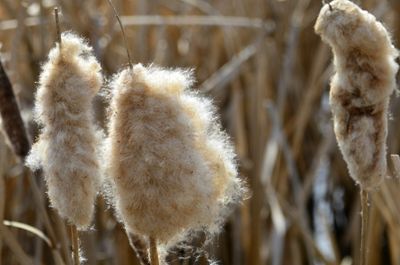Collecting Cattail Seeds
Saving cattail seeds and planting them where you want these fabulous plants helps create a wild animal sanctuary and waterfowl habitat. It is quite easy to do and an excellent way to replant a devastated marsh or waterway. A single cattail can contain up to 25,000 seeds, which can go a long way to repopulating a native species. Some tips on how to plant cattail seeds once you have harvested them, can speed you on the way to a useful and beautiful stand of these one-time native foods. Cattail seed saving was probably practiced by indigenous people for hundreds of years. The plant was a popular food and cordage, and keeping existing stands healthy would have been important. While the plant reseeds itself readily, in disturbed sites, reestablishing a colony may require some human intervention. Saving cattail seeds from wild plants will provide the raw materials for such an endeavor and doesn’t require the harvest of more than 1 or 2 seed heads. Cattails need a wet area with low salinity, water flow and plenty of nutrient influx. Seeds will germinate in a wide range of conditions and temperatures provided there is adequate moisture. You may also choose to start seed in containers and plant them outdoors after freezing temperatures have passed.
What to Do with Cattail Seeds
Wait until the seed head has ripened. You can tell when this is by the deep rusty brown color and dry texture of the seed head. Often, the seeds will have started to burst open and show fuzzy white structures which help the seed disperse through wind. The best time for collecting cattail seeds is in late summer to very early fall. Cut off the seed head and separate the seed from the stem. Do this by placing the head in a bag and stripping off the seed into the bag. This can be facilitated by allowing the head to dry for 1 or 2 weeks in a paper bag. Water promotes germination, so soak the seeds in water for 24 hours prior to planting.
How to Plant Cattail Seeds
Compost makes a great medium for seeding cattails. Fill cardboard containers or egg crates with compost that has a third fine sand mixed into it to promote draining. Separate each seed and plant them on the surface of the moistened medium and cover with a fine sift of sand. You can then place containers in a larger container with a level of water that reaches your second knuckle or create a humidity chamber for the plants. To do this, cover the containers with the seed with plastic or a clear dome. Mist plants to keep the top surface of the soil moderately wet. In most cases, germination will occur in two weeks provided temperatures are at least 65 degrees Fahrenheit (18 C.). Higher temperatures cause earlier germination. Keep seedlings well-watered and transplant them in late summer to a moist location.
